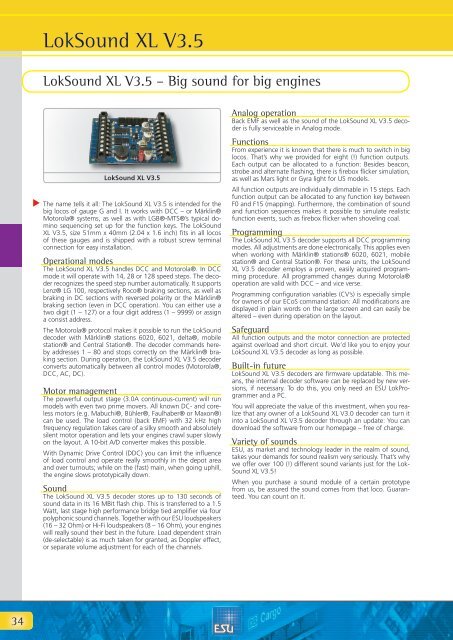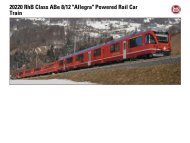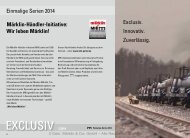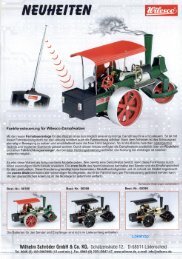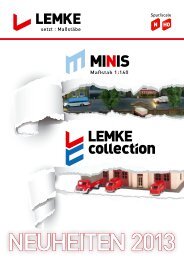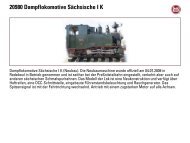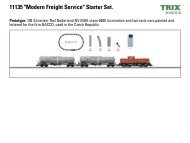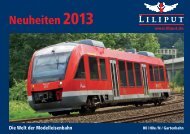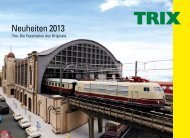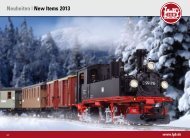Product Overview 2010 - Lokshop
Product Overview 2010 - Lokshop
Product Overview 2010 - Lokshop
You also want an ePaper? Increase the reach of your titles
YUMPU automatically turns print PDFs into web optimized ePapers that Google loves.
34<br />
u<br />
LokSound XL V3.5<br />
LokSound XL V3.5 – Big sound for big engines<br />
LokSound XL V3.5<br />
The name tells it all: The LokSound XL V3.5 is intended for the<br />
big locos of gauge G and I. It works with DCC – or Märklin®<br />
Motorola® systems, as well as with LGB®-MTS®’s typical domino<br />
sequencing set up for the function keys. The LokSound<br />
XL V3.5, size 51mm x 40mm (2.04 x 1.6 inch) fits in all locos<br />
of these gauges and is shipped with a robust screw terminal<br />
connection for easy installation.<br />
Operational modes<br />
The LokSound XL V3.5 handles DCC and Motorola®. In DCC<br />
mode it will operate with 14, 28 or 128 speed steps. The decoder<br />
recognizes the speed step number automatically. It supports<br />
Lenz® LG 100, respectively Roco® braking sections, as well as<br />
braking in DC sections with reversed polarity or the Märklin®<br />
braking section (even in DCC operation). You can either use a<br />
two digit (1 – 127) or a four digit address (1 – 9999) or assign<br />
a consist address.<br />
The Motorola® protocol makes it possible to run the LokSound<br />
decoder with Märklin® stations 6020, 6021, delta®, mobile<br />
station® and Central Station®. The decoder commands hereby<br />
addresses 1 – 80 and stops correctly on the Märklin® braking<br />
section. During operation, the LokSound XL V3.5 decoder<br />
converts automatically between all control modes (Motorola®,<br />
DCC, AC, DC).<br />
Motor management<br />
The powerful output stage (3.0A continuous-current) will run<br />
models with even two prime movers. All known DC- and coreless<br />
motors (e.g. Mabuchi®, Bühler®, Faulhaber® or Maxon®)<br />
can be used. The load control (back EMF) with 32 kHz high<br />
frequency regulation takes care of a silky smooth and absolutely<br />
silent motor operation and lets your engines crawl super slowly<br />
on the layout. A 10-bit A/D converter makes this possible.<br />
With Dynamic Drive Control (DDC) you can limit the influence<br />
of load control and operate really smoothly in the depot area<br />
and over turnouts; while on the (fast) main, when going uphill,<br />
the engine slows prototypically down.<br />
Sound<br />
The LokSound XL V3.5 decoder stores up to 130 seconds of<br />
sound data in its 16 MBit flash chip. This is transferred to a 1.5<br />
Watt, last stage high performance bridge tied amplifier via four<br />
polyphonic sound channels. Together with our ESU loudspeakers<br />
(16 – 32 Ohm) or Hi-Fi loudspeakers (8 – 16 Ohm), your engines<br />
will really sound their best in the future. Load dependent strain<br />
(de-selectable) is as much taken for granted, as Doppler effect,<br />
or separate volume adjustment for each of the channels.<br />
Analog operation<br />
Back EMF as well as the sound of the LokSound XL V3.5 decoder<br />
is fully serviceable in Analog mode.<br />
Functions<br />
From experience it is known that there is much to switch in big<br />
locos. That’s why we provided for eight (!) function outputs.<br />
Each output can be allocated to a function: Besides beacon,<br />
strobe and alternate flashing, there is firebox flicker simulation,<br />
as well as Mars light or Gyra light for US models.<br />
All function outputs are individually dimmable in 15 steps. Each<br />
function output can be allocated to any function key between<br />
F0 and F15 (mapping). Furthermore, the combination of sound<br />
and function sequences makes it possible to simulate realistic<br />
function events, such as firebox flicker when shoveling coal.<br />
Programming<br />
The LokSound XL V3.5 decoder supports all DCC programming<br />
modes. All adjustments are done electronically. This applies even<br />
when working with Märklin® stations® 6020, 6021, mobile<br />
station® and Central Station®. For these units, the LokSound<br />
XL V3.5 decoder employs a proven, easily acquired programming<br />
procedure. All programmed changes during Motorola®<br />
operation are valid with DCC – and vice verse.<br />
Programming configuration variables (CV’s) is especially simple<br />
for owners of our ECoS command station: All modifications are<br />
displayed in plain words on the large screen and can easily be<br />
altered – even during operation on the layout.<br />
Safeguard<br />
All function outputs and the motor connection are protected<br />
against overload and short circuit. We’d like you to enjoy your<br />
LokSound XL V3.5 decoder as long as possible.<br />
Built-in future<br />
LokSound XL V3.5 decoders are firmware updatable. This means,<br />
the internal decoder software can be replaced by new versions,<br />
if necessary. To do this, you only need an ESU LokProgrammer<br />
and a PC.<br />
You will appreciate the value of this investment, when you realize<br />
that any owner of a LokSound XL V3.0 decoder can turn it<br />
into a LokSound XL V3.5 decoder through an update: You can<br />
download the software from our homepage – free of charge.<br />
Variety of sounds<br />
ESU, as market and technology leader in the realm of sound,<br />
takes your demands for sound realism very seriously. That’s why<br />
we offer over 100 (!) different sound variants just for the Lok-<br />
Sound XL V3.5!<br />
When you purchase a sound module of a certain prototype<br />
from us, be assured the sound comes from that loco. Guaranteed.<br />
You can count on it.


